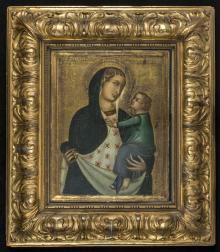Back
Pious Customs: Religious Painting in European Art
Copy after Pietro Lorenzetti, Madonna and Child, 18 - 19th century. Estate of Roy and Jeanne Neville
Pious Customs: Religious Painting in European Art
April 06, 2024 to March 16, 2025
In 726 CE, the iconoclast controversy erupted in Constantinople, resulting in the systemic destruction of religious images and the prohibition of religious icons throughout Christian Byzantium. The next six decades of iconoclasm, followed by a brief resurgence in the ninth century, permanently shaped the development and divergence of Eastern Orthodox religious art from the developing religious painting traditions in Western and Central Europe. Pious Customs: Religious Painting in European Art examines a selection of Orthodox icons and religious painting from Italy, France, and the Netherlands, ranging from the 14th to the 20th century. As a comparative exhibition, it aims to illustrate the diverging traditions of European religious art, but also the iconographic and stylistic similarities fostered by complex networks of trade, cultural exchange, and interaction between Christian Byzantium and Europe. This exhibition was curated by Alexis Garcia, Post-Graduate Museum Fellow in European & American Art, and Margaryta Golovchenko, PhD candidate in the Department of the History of Art and Architecture, using works from the JSMA’s icon collection courtesy of A. Dean and Lucile I. McKenzie and loaned objects from the Metropolitan Museum of Art.






